Welcome to our article on Subwassertang, a captivating aquatic plant that adds beauty and life to freshwater aquariums. Whether you’re an experienced hobbyist or just starting out, Subwassertang is an excellent choice for your aquarium.
With its unique appearance, low maintenance requirements, and numerous benefits, this plant is sure to enhance the aesthetics and overall health of your underwater ecosystem.
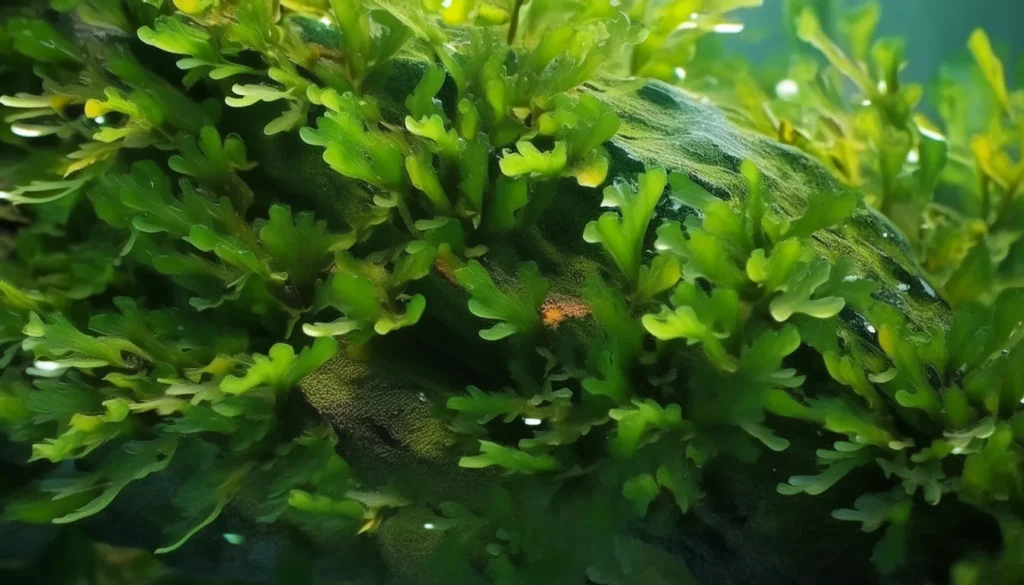
Subwassertang, also known as a submerged plant or live plant, is a popular decorative plant among aquarium enthusiasts. Its feathery fronds create a dense mat-like structure, giving your aquarium a natural and picturesque look.
Additionally, Subwassertang’s ability to thrive in various water conditions makes it a versatile choice for any freshwater aquarium.
Key Takeaway
- Subwassertang is a decorative aquatic plant that enhances the aesthetics of freshwater aquariums.
- It is a submerged plant that grows entirely underwater, adding beauty to the aquarium.
- Subwassertang is a low-maintenance plant, making it suitable for both beginner and experienced hobbyists.
- Adding Subwassertang to your aquarium can create a visually appealing and natural underwater ecosystem.
- Its dense mat-like structure provides shelter and hiding places for fish and other aquatic organisms.
Quick Stats
| Attribute | Details |
| Scientific Name | Lomariopsis sp. or Riccardia sp. |
| Common Name | Subwassertang, Round Pellia, Pellia Moss |
| Origin | Asia, particularly Japan and Southeast Asia |
| Height | Variable, typically low-growing |
| pH Range | 6.0 – 7.5 |
| CO2 Requirement | Low to Moderate |
| Growth Rate | Slow to Moderate |
| Care Level | Easy to Moderate |
| Color Form | Dark green, with a dense and bushy appearance |
| Water Conditions | 20-28°C (68-82°F), adaptable to a wide range of water parameters |
| Max Size | Typically remains small, forming dense mats |
| Lighting | Low to Moderate |
| Supplements | Minimal; benefits from occasional liquid fertilization |
| Placement | Foreground to Mid-ground |
| Propagation | Fragmentation or by attaching small portions to surfaces |
What Is Subwassertang?
Subwassertang is an aquatic plant commonly used in freshwater aquariums. This fascinating plant, also known as “round pellia” or “liverwort,” is native to Southeast Asia, particularly found in slow-moving or stagnant water bodies.
Its unique appearance and versatility make it a popular choice for aquarium enthusiasts.
Subwassertang features feathery, fern-like fronds that create a dense mat, resembling a miniature underwater forest. The plant’s lush texture and vibrant green color add visual interest and depth to any aquariumscape.
As an aquatic plant, Subwassertang serves multiple purposes. It can be used as a decorative plant in aquascaping, enhancing the aesthetics of the aquarium.
Additionally, Subwassertang acts as a natural filtration system, helping to maintain water quality by absorbing excess nutrients and providing a conducive environment for beneficial bacteria to thrive.
Natural Habitat And Origin
- Natural Habitat: Subwassertang is native to regions of Southeast Asia, including countries such as Thailand, Malaysia, and Indonesia. It is typically found in slow-moving or still bodies of water, such as streams, rivers, ponds, and marshes, where it attaches itself to rocks, wood, or substrate. Subwassertang grows submersed in its natural habitat, forming dense mats or clumps.
- Origin: The exact origin of Subwassertang in the aquarium hobby is not definitively known. It likely entered the hobby through the trade of aquatic plants from its native regions in Southeast Asia. It has gained popularity among aquarists for its unique appearance, ease of care, and ability to thrive in a wide range of aquarium conditions.

Physical Characteristics
- Shape and Structure: Subwassertang typically forms dense mats or clusters composed of delicate, fern-like fronds. The plant’s structure consists of small, round or oval-shaped segments attached to a central rhizome. These segments are interconnected by thin, branching filaments, creating a branching and intricate appearance.
- Texture: The texture of Subwassertang is soft, feathery, and finely branched, resembling a cross between moss and fern. The fronds are delicate and flexible, with a slight translucency that gives them a delicate and ethereal quality.
- Color: Subwassertang exhibits various shades of green, ranging from light green to darker hues, depending on factors such as lighting and water parameters. The coloration may appear slightly iridescent or shimmering under certain lighting conditions.
- Size: The size of individual Subwassertang fronds can vary, but they typically range from a few millimeters to several centimeters in diameter. In aquariums, Subwassertang can form dense mats or carpets, covering rocks, driftwood, or substrate surfaces.
- Attachment: Subwassertang attaches itself to surfaces using rhizoids, which are thin, hair-like structures that anchor the plant to rocks, driftwood, or substrate. It can be easily attached using thread, glue, or other methods to create desired aquascape layouts.
Lighting Needs
- Intensity: Subwassertang can tolerate moderate to high-intensity lighting, but it does not require extremely bright lighting like some other aquatic plants. Moderate lighting levels are generally sufficient to support healthy growth and maintain the plant’s vibrant green coloration.
- Duration: Provide a consistent photoperiod of 8 to 10 hours of light per day to simulate a natural day-night cycle. Avoid excessive or prolonged lighting periods, as this can promote algae growth and may stress the plant.
- Quality: Use full-spectrum aquarium lighting with a color temperature between 5000K to 7000K for optimal plant growth. LED or fluorescent lights are commonly used in planted aquarium setups and provide sufficient spectrum for photosynthesis.
- Light Penetration: Ensure that the aquarium receives adequate light penetration to reach all areas where Subwassertang is planted. Avoid shading the plant with tall decorations or densely planted areas, as this can inhibit growth and lead to leggy or sparse growth.
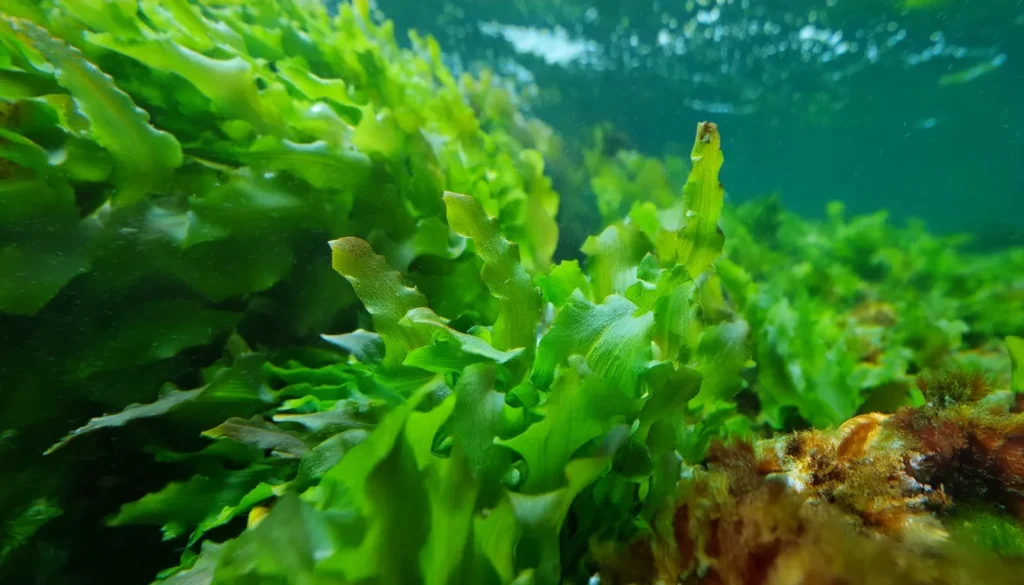
Temperature Parameters
- Temperature Range: Subwassertang can thrive within a temperature range typically suitable for tropical freshwater aquariums. The ideal temperature range for Subwassertang is approximately 20°C to 28°C (68°F to 82°F).
- Optimal Temperature: Within the recommended range, aim for a temperature around 24°C to 26°C (75°F to 79°F) for optimal growth and health of Subwassertang. This temperature range closely mimics the conditions found in its native habitats in Southeast Asia.
- Stability: Maintain stable temperature conditions within the aquarium to prevent temperature fluctuations, which can stress the plants and negatively impact their growth. Use a reliable aquarium heater and thermometer to monitor and regulate the water temperature consistently.
- Avoid Extremes: Avoid exposing Subwassertang to temperature extremes outside of its preferred range, as this can lead to stress, reduced growth, and susceptibility to diseases. Sudden changes in temperature should also be avoided to prevent shock to the plants.
Nutrient Control And Water Quality Enhancement
- One significant advantage of incorporating Subwassertang in a blackwater or botanical-style tank is its ability to control nutrient levels and enhance water quality.
- As the plant absorbs excess nutrients in the water, it helps prevent imbalances that can lead to the growth of unsightly and potentially harmful algae. By acting as a natural filter, Subwassertang promotes a cleaner and healthier aquatic environment for your tank inhabitants.
- In addition to nutrient control, Subwassertang also contributes to water quality enhancement. It has the remarkable ability to remove toxins, pollutants, and heavy metals from the water, thereby creating a safe and optimal habitat for your aquatic organisms. The plant’s efficient filtration properties make it an invaluable asset in maintaining overall water clarity and purity.
Substrate Requirement
- Substrate Type: Subwassertang can be attached to almost any type of aquarium substrate, including sand, gravel, and aquatic soil. The choice of substrate type depends on personal preference and the overall aquascape design.
- Texture: Choose a substrate with a fine to medium texture that allows Subwassertang to attach securely and form a stable base. Avoid substrates with large or sharp particles that may damage the plant or inhibit attachment.
- Nutrient Content: While Subwassertang obtains most of its nutrients from the water column and through foliar absorption, providing a nutrient-rich substrate can supplement its growth. Consider using a nutrient-rich substrate specifically formulated for planted aquariums or adding root tabs to the substrate to provide essential nutrients.
- pH and Hardness: Subwassertang can adapt to a wide range of pH and water hardness levels commonly found in aquariums. However, maintaining stable and suitable water parameters is essential for overall plant health and growth.
- Depth: The depth of the substrate layer is not critical for Subwassertang, as it primarily attaches itself to surfaces rather than rooting into the substrate. Aim for a substrate depth of at least 1 to 2 inches (2.5 to 5 centimeters) to provide stability for the plant and anchor any attached portions securely.
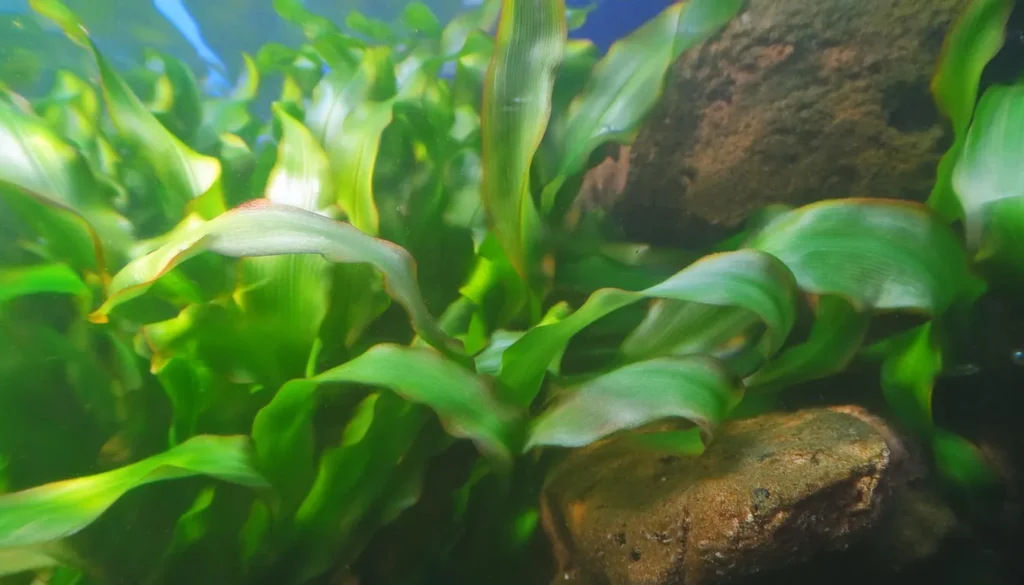
Placement Option
- Foreground: Subwassertang can be placed in the foreground of the aquarium to create a lush carpeting effect. Attach the plant to the substrate using thread, fishing line, or aquarium-safe glue, spacing the portions closely together to encourage horizontal growth and create a dense carpet.
- Midground: Subwassertang can also be placed in the midground of the aquarium, where it can serve as a focal point or transition between the foreground and background plants. Attach the plant to rocks, driftwood, or other decorations using the same methods as for the substrate attachment.
- Background: While Subwassertang is not typically used as a background plant due to its low-growing nature, it can still be incorporated into the background of the aquarium for added texture and visual interest. Attach portions of Subwassertang to the back glass or taller decorations to create a layered effect.
RELATED: Grow Cryptocoryne Lutea For Vibrant Aquariums With This Simple Guide
Recommended Tank Size
- Nano Aquariums: Subwassertang is well-suited for nano aquariums with a capacity of 5 gallons (19 liters) or larger. Its small size and low-maintenance requirements make it an excellent choice for small-scale setups, such as desktop or tabletop aquariums.
- Small to Medium Aquariums: Subwassertang can also thrive in small to medium-sized aquariums ranging from 10 gallons (38 liters) to 50 gallons (189 liters). These aquarium sizes provide ample space for planting Subwassertang in the foreground, midground, or background, depending on the desired aquascape layout.
- Large Aquariums: In larger aquariums exceeding 50 gallons (189 liters), Subwassertang can be used as a foreground or midground plant to create a lush carpeting effect or add texture to the aquascape. Larger tanks offer more flexibility in terms of aquascape design and placement options for Subwassertang.
- Species-specific Tanks: Subwassertang can be incorporated into species-specific tanks dedicated to shrimp, small fish, or other aquatic inhabitants. Tanks of various sizes, such as shrimp nano tanks or betta aquariums, can accommodate Subwassertang as a decorative and functional element of the habitat.
Suitable Tank Mates
- Small Fish: Peaceful and small-sized fish species that won’t disturb the substrate or plants are suitable tank mates for Subwassertang. Examples include neon tetras, rasboras, endlers, guppies, dwarf gouramis, and small species of Corydoras catfish.
- Shrimp: Dwarf shrimp species such as Cherry Shrimp, Crystal Red Shrimp, Amano Shrimp, and Ghost Shrimp make excellent tank mates for Subwassertang. They help to clean algae and detritus from the aquarium while peacefully coexisting with the plants.
- Snails: Some species of freshwater snails, such as Nerite Snails, Mystery Snails, and Malaysian Trumpet Snails, can be compatible with Subwassertang. They help to graze on algae and keep the aquarium clean without posing a threat to the plants.
- Bottom Dwellers: Bottom-dwelling fish species that remain relatively small and don’t disturb the substrate can be good tank mates for Subwassertang.
Nutritional Needs
- Macro and Micronutrients: Subwassertang requires essential macro and micronutrients for healthy growth, including nitrogen, phosphorus, potassium, iron, calcium, magnesium, and trace elements. These nutrients can be supplied through regular water changes, fish waste, and the decomposition of organic matter in the aquarium.
- Liquid Fertilization: While Subwassertang primarily absorbs nutrients through its leaves, supplementing with a liquid fertilizer formulated for aquarium plants can provide additional nutrients to support healthy growth. Choose a comprehensive liquid fertilizer that contains macro and micronutrients, and dose according to the manufacturer’s instructions.
- Root Tabs: Although Subwassertang does not root deeply into the substrate, providing root tabs or nutrient-rich substrate additives can supplement its nutrient uptake. Root tabs are small tablets placed in the substrate near the plant’s roots to provide a localized source of nutrients.
- CO2 Supplementation: While not strictly necessary, supplementing carbon dioxide (CO2) in high-tech planted aquarium setups can enhance the growth and health of Subwassertang. CO2 supplementation promotes photosynthesis and can help prevent algae growth by encouraging robust plant growth.
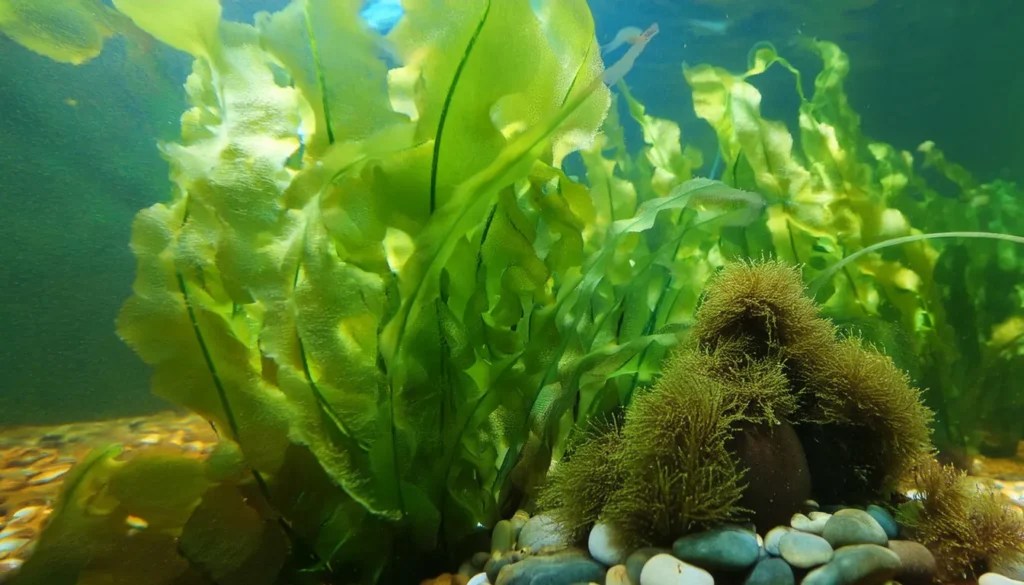
Subwassertang Cultivation Tips
- Provide Stable Water Parameters: Maintain stable and optimal water parameters, including temperature, pH, and hardness, to create a conducive environment for Subwassertang. Aim for a temperature range of 20°C to 28°C (68°F to 82°F), slightly acidic to neutral pH (6.5 to 7.5), and moderate water hardness.
- Provide Adequate Lighting: Subwassertang can thrive under moderate to high-intensity lighting. Provide a consistent photoperiod of 8 to 10 hours of light per day using full-spectrum aquarium lighting with a color temperature between 5000K to 7000K. Adjust lighting intensity as needed based on plant growth and observations.
- Supplement with CO2 (Optional): While not strictly necessary, supplementing carbon dioxide (CO2) in high-tech planted aquarium setups can enhance the growth and health of Subwassertang. CO2 supplementation promotes photosynthesis and can help prevent algae growth by encouraging robust plant growth.
- Attach to Hardscape or Substrate: Attach Subwassertang to hardscape elements such as rocks, driftwood, or decorations using thread, fishing line, or aquarium-safe glue. Alternatively, you can attach it to the substrate by burying portions of the plant’s rhizome in the substrate.
Plant Propagation Tips
- Division: Subwassertang can be propagated by dividing the plant into smaller portions. Gently separate the plant into individual segments or clusters, ensuring that each portion has a portion of the rhizome attached. Use clean, sharp scissors or aquascaping tools to carefully divide the plant without damaging the rhizome or fronds.
- Attachment: Once divided, attach the individual portions of Subwassertang to desired surfaces in the aquarium. Use thread, fishing line, or aquarium-safe glue to secure the plant to hardscape elements such as rocks, driftwood, or decorations. Alternatively, bury a portion of the rhizome in the substrate to anchor the plant.
- Spacing: When attaching Subwassertang to surfaces, ensure that the portions are spaced closely together to encourage horizontal growth and create a dense carpeting effect. This helps promote healthy growth and prevents gaps between individual portions.
- Optimal Conditions: Provide optimal growing conditions for the newly propagated Subwassertang portions, including suitable lighting, water parameters, and nutrient levels. Maintain stable and consistent conditions to minimize stress and promote rapid establishment.
Benefits Of Planting Subwassertang
- Natural Appearance: Subwassertang adds a natural and organic look to the aquarium with its delicate, fern-like fronds and branching structure. Its feathery texture and vibrant green coloration create a visually appealing contrast against other aquarium elements.
- Texture and Depth: Subwassertang provides texture and depth to the aquascape, whether used as a foreground carpeting plant, midground filler, or background accent. Its dense growth habit and intricate branching create a lush and layered appearance in the aquarium.
- Habitat for Fish and Invertebrates: Subwassertang serves as a habitat and refuge for small fish, shrimp, and other aquarium inhabitants. The dense mats of Subwassertang provide hiding spots, shelter, and grazing areas for fish and invertebrates, helping to reduce stress and promote natural behavior.
- Water Filtration: Subwassertang contributes to water filtration and quality by absorbing excess nutrients, organic waste, and harmful substances from the water column. Its dense growth helps to oxygenate the water and reduce the accumulation of algae by competing for nutrients.
- Low Maintenance: Subwassertang is relatively low-maintenance compared to some other aquarium plants, making it suitable for beginners and experienced aquarists alike. It tolerates a wide range of water parameters and lighting conditions and requires minimal pruning and care to maintain its appearance.
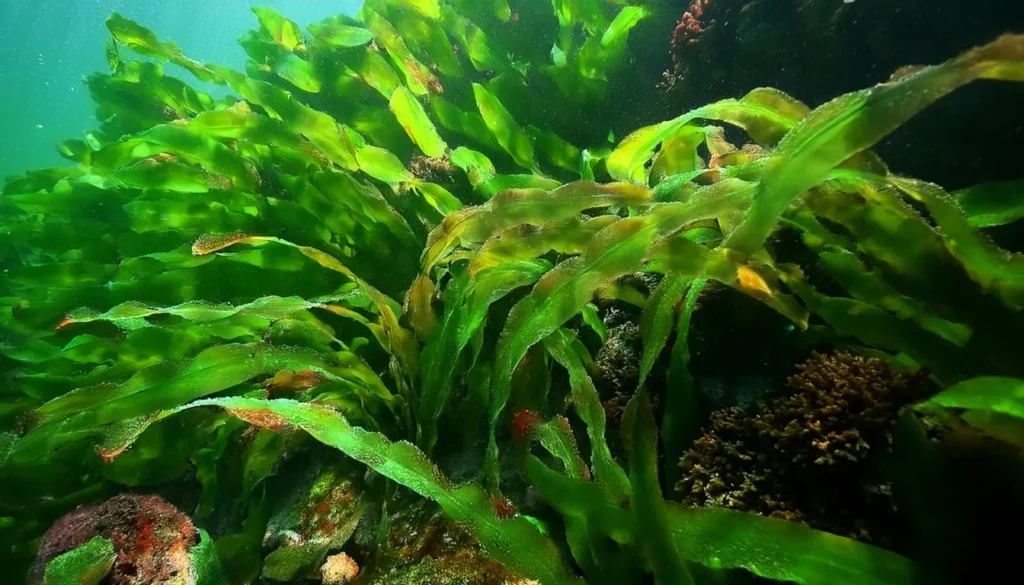
Conclusion
Subwassertang is truly an exceptional aquatic plant that brings natural beauty and numerous benefits to freshwater aquariums. Its unique appearance, with feathery fronds and a dense mat-like structure, adds elegance to any aquascape.
Not only is it visually appealing, but Subwassertang also serves important functions in maintaining water quality and supporting the overall health of the aquarium ecosystem.
One of Subwassertang’s key advantages is its low-maintenance nature. This makes it a popular choice among hobbyists who want to enjoy the beauty of live plants without extensive care requirements.
By providing moderate to high lighting and stable water conditions, hobbyists can ensure optimal growth of Subwassertang in their aquarium.
Integrating Subwassertang into a freshwater aquarium has countless benefits. It helps control nutrient levels, reduces algae growth, enhances water quality by removing toxins and pollutants, and provides shelter for fish and invertebrates.
By following the care tips and guidance mentioned in this article, hobbyists can easily create a thriving underwater ecosystem with Subwassertang as a key component.
Frequently Asked Questions
Why Are Aquatic Plants Important In Aquariums?
Aquatic plants play a crucial role in freshwater aquariums as they provide various benefits to the ecosystem. They help maintain water quality by absorbing excess nutrients like nitrates and phosphates, reducing the risk of algae blooms.
Aquatic plants also release oxygen through photosynthesis, improving the overall oxygen levels in the aquarium and supporting the health of fish and other organisms.
They offer shelter and hiding places for fish and invertebrates, reducing stress and providing a natural environment for them to thrive.
How Does Subwassertang Benefit Blackwater And Botanical-Style Tanks?
Due to its unique properties, Subwassertang is particularly beneficial in blackwater and botanical-style tanks. It helps control nutrient levels in the water by absorbing excess nutrients and reducing the risk of imbalances that can lead to algae growth.
Subwassertang contributes to water quality enhancement by removing toxins, pollutants, and heavy metals, creating a healthier environment for aquatic organisms.
How Do I Care For Subwassertang In My Aquarium?
Subwassertang is a low-maintenance plant, making it ideal for hobbyists looking for easy-care options in their aquariums. It thrives in a wide range of water conditions, including pH levels between 6.0 and 7.5 and temperatures between 72°F and 82°F.
To promote optimal growth, provide moderate to high lighting and ensure a stable water environment. Propagation can be done by dividing the plant into smaller portions and attaching them to rocks or driftwood using thread or fishing lines.
Pruning is minimal as Subwassertang naturally grows in a dense mat, but occasional trimming may be needed to maintain the desired shape and size.
Can Subwassertang Be Integrated Into A Community Tank?
Yes, Subwassertang can be integrated into a community tank to provide multiple benefits to the aquarium inhabitants. It serves as a refuge for shy fish and invertebrates, providing hiding places and creating a more natural and secure environment for them.
In nursery tanks, Subwassertang can be used to provide shelter and food sources for fry, aiding in their growth and survival.
What Impact Does Subwassertang Have On Freshwater Ecosystems?
Subwassertang, along with other submerged plants, plays a crucial role in freshwater ecosystems by contributing to habitat formation. It provides shelter, food sources, and breeding grounds for various aquatic organisms, supporting overall biodiversity.
Submerged plants also help improve water quality by absorbing excess nutrients and providing oxygen through photosynthesis.
- Unveiling The Wonders Of Riccia Fluitans In Aquascapes - August 7, 2024
- Vallisneria Gigantea Var. Guide To Care And Cultivation At Home - July 31, 2024
- Vesicularia Dubyana Care & Growth Guide Tips For Beginner Gardeners - July 30, 2024
